Florida Vines: Flowering, Evergreen (With Pictures)

Flowering and evergreen vines are ideal landscaping solutions for Florida gardens. Climbing plants with flowers or evergreen foliage can grow on trellises, over arbors and pergolas, or hide fences. Additionally, flowering plants with spreading stems can grow as ground cover, help screen a backyard, cascade over a wall, or look stunning in a hanging basket on a patio. Regardless of your landscaping goals, many types of vines are ideal for Florida landscapes.
Flowering and evergreen vines are a great way to add color, texture, and height to your front or backyard. However, choosing vining plants can be challenging for Florida’s diverse climate. For example, some vines that thrive in the south on the Florida Peninsula may struggle in the winter in the colder climate of North Florida.
This article explores 18 of the most popular vines that grow in Florida. You will learn about their characteristics, see pictures of Florida vines, and learn how to use them in landscaping.
The Best Flowering Florida Vines
The best Florida vines are climbing plants that thrive in USDA growing zones 8 to 11. Some vines attach themselves to trellises, lattice frames, obelisks, or chain link fences with clinging tendrils or twining stems. Other flowering evergreen vines require support to grow against a wall or other structure.
Some of the most impressive flowering plants in Florida with tendril stems are passion flower vines (Passiflora), crossvine (Bignonia capreolata), and several varieties of grapevines (Vitis spp.). Some of these climbers have spectacular showy flowers in purple, red, and orange colors.
However, suppose you have a sturdy trellis or arbor. In that case, American wisteria (Wisteria frutescens) climbs over structures with its woody twining stems. Another stunning vine for Florida landscapes is bougainvillea, whose flexible stems you can lace through trellis supports.
If you want vines that cover fences, walls, or trellises to define outdoor spaces, then Virginia creeper is an ideal choice. This fast-growing vine has stems with sticky pads that attach themselves to hard surfaces.
Some of the best tropical vines to grow in Central and South Florida are golden pothos (Epipremnum aureum), philodendron (Philodendron spp.), and Swiss cheese plant (Monstera deliciosa). These evergreen vines typically grow as houseplants in cooler climates but thrive throughout the year in tropical regions.
Native Florida Vines
Vines native to Florida are exotic climbing and trailing plants adapted to the local flora. These vining plants don’t become invasive, choke, or compete with other native plants for space or nutrients. Additionally, native Florida vines support wildlife, including butterflies, hummingbirds, and native insects.
Here are some of the most outstanding native Florida vines:
- Crossvine (Bignonia capreolata)
- Carolina jessamine (Gelsemium sempervirens)
- Wild passion flower (Passiflora incarnata)
- Coral honeysuckle (Lonicera sempervirens)
- Virginia Virgin’s Bower (Clematis virginiana)
Flowering Florida Vines (With Pictures) – Identification Guide
A wide variety of flowering vines are perfect for adding beautiful blooms and fragrant scents to Florida landscapes. Here are nine impressive vines with flowers that bloom throughout the summer—and some even longer—in Florida’s tropical, subtropical, and coastal landscapes.
Wild Passion Flower (Passiflora incarnata)
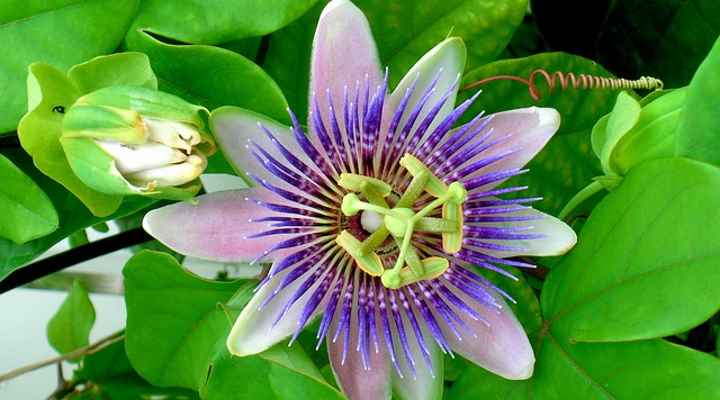
Wild passion flower is a native Florida vine with stunning purple flowers that thrives in full sun and looks great covering fences or arbors
Wild passion flower is a beautiful, exotic flowering vine native to Florida and the southeastern United States. The elaborate feature of passion flower vines is the showy purple flowers with wiry filaments and a fascinating yellowish center. This tendril-climbing vine also has three-lobed leaves that drop in the fall.
Native wild passion flower vines grow 6 to 8 ft. (1.8 – 2.4 m) tall and 6 ft. (1.8 m) wide. These spectacular fast-growing climbers bloom from mid-summer through fall in Central and Southern Florida. They are an excellent landscaping choice for fences, trellises, arbors, walls, or to define borders.
There are also several varieties of white-flowering passion vines with stunning ivory-white blooms.
Suitable for USDA zones 6 to 11.
American Wisteria (Wisteria frutescens)
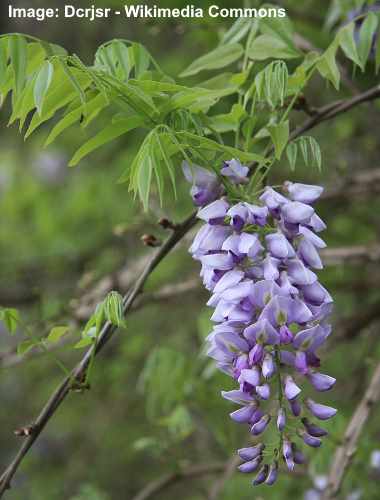
American wisteria is a flowering vine with beautiful purple flowers as well as cultivars with white flowers
American wisteria is a native woody flowering vine with strong twining stems and stunning clusters of purple flowers. Wisteria is known for its densely-packed conical flower clusters of pea-like lavender flowers. Additionally, wisteria has pinnate leaves, each with nine to 15 smaller leaflets. Attractive dangling seed pods appear in summer and persist until winter.
Native to Florida, American wisteria is less invasive than its Asian counterparts, which can be invasive and aggressive. The vigorous purple-flowering vine grows 15 to 30 ft. (4 – 9 m) tall and 8 ft. (2.4 m) wide. Climbing American wisterias are ideal for pergolas, arbors, trellises, or growing against a house.
Because the woody stems are strong, the climber requires sturdy support.
American wisteria is suitable for landscaping front or backyards in Central and Northern Florida (USDA zones 5 to 9).
Crossvine (Bignonia capreolata)
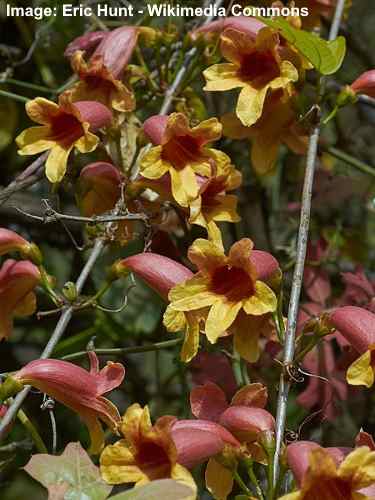
Crossvine is a fast growing vining plant with multi-colored, trumpet-shaped flowers suitable for northern and central Florida
Crossvine (also written cross vine) is a fast-growing, evergreen flowering vine native to Florida. This self-clinging woody vine is famous for its stunning trumpet-shaped flowers and wonderful fragrance. The exotic tubular blooms are bright red, orange, or yellow and appear in spring and persist through summer. After flowering, greenish seed pods decorate the floral vine.
Crossvine is native to Florida and the southeastern United States. This woody climber grows 30 to 50 ft. (9 – 15 m) tall and up to 9 ft. (2.7 m) wide. Thanks to the masses of brightly colored flowers and dense foliage, it’s an excellent choice for privacy screening, and covering walls, fences, trellises, and arbors.
Suitable for USDA zones 6 to 9.
Virginia Virgin’s Bower (Clematis virginiana)
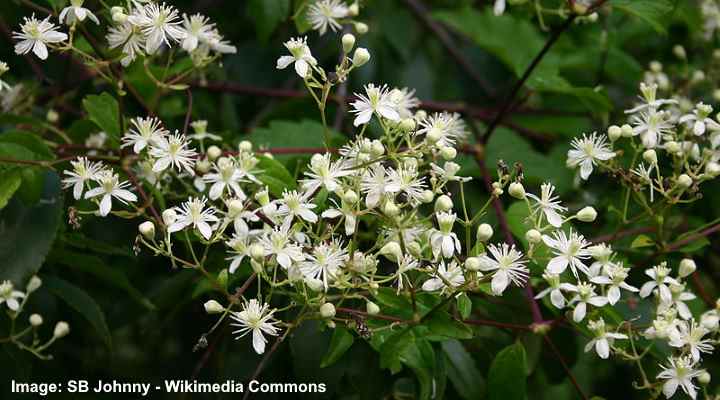
Virginia virgin’s bower is perennial, rapid-growing climbing plant native to Florida with aromatic white flowers
Virginia virgin’s bower is a type of clematis vine that produces masses of fragrant star-shaped white flowers in summer and fall. The pure white, four-petalled blooms have showy yellowish stamens in the center. After flowering, the native vine is covered with attractive fluffy seed heads that persist until winter.
Virginia virgin’s bower is native to Florida. Its vining stems support themselves on trellises, arbors, or fences using twisting stems that wrap around supports. Without support, you can grow a virgin’s bower as white-flowering ground cover in Central and North Florida.
This fast-growing vining plant grows 10 to 20 ft. (3 – 6 m) tall and 6 ft. (1.8 m) wide. It’s a cold-hardy vine that thrives in USDA zones 3 to 9.
Other varieties of clematis vines native to Florida include swamp leather flower (Clematis crispa), pine-hyacinth (Clematis baldwinii), and Netleaf Virgin’s-bower (Clematis reticulata).
Sensitive Briar (Mimosa quadrivalvis)
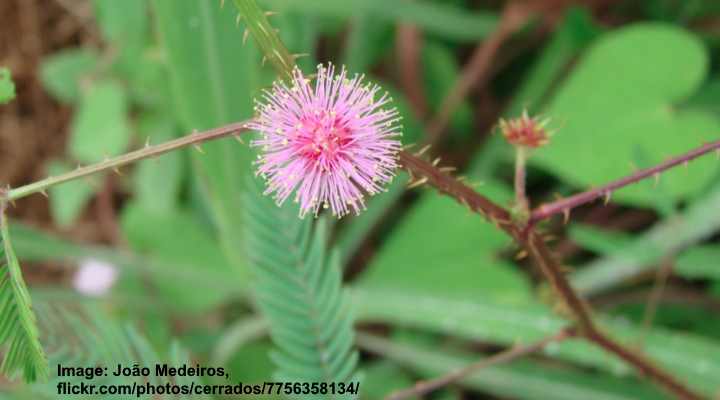
Sensitive briar is a trailing vine that can be also grown as a full sun ground cover plant in Florida gardens
Sensitive briar is a pink-flowering perennial tropical vine with stunning ball-shaped blooms, twice pinnately compound leaves, and clambering stems. The vine’s puffball flowers are magenta or pink, yellow-tipped stamens that bloom from spring until fall. In addition, the interesting leaves are typical of mimosa plants consisting of tiny leaflets.
This creeping or trailing vine grows 1 to 2 ft. (0.3 – 0.6 m) tall and up to 4 ft. (1.2 m) wide. It’s ideal for growing in Central and South Florida due to its resistance to drought, constant sunshine, and dry soils. The vining plant performs well supported on trellises or left to grow as ground cover for full sun.
Suitable for USDA zones 9 and 10.
Coral Honeysuckle (Lonicera sempervirens)

Coral honeysuckle is a vigorous climbing plant with red flowers that grows best in full sun but can tolerate part shade
Coral honeysuckle is a twining, evergreen flowering vine with bright red tubular flowers and glossy dark-green foliage. The slender trumpet-shaped scarlet blooms measure 2” (5 cm) long and grow in whorled clusters. After flowering, bright red berries appear in spring and last until fall. Many people consider coral honeysuckle to be the showiest native vine.
Also called trumpet honeysuckle, this red-flowering climbing plant grows 8 to 15 ft. (2.4 – 4.5 m) tall and 6 ft. (1.8 m) wide. The ornamental vine thrives in full sun and easily climbs over arbors, fences, walls, or pergolas. This ensures a stunning floral display throughout the season.
Coral honeysuckle grows as an evergreen vine in warm winter climates like Central and South Florida. It is suitable for USDA zones 4 to 9.
Flame Vine (Pyrostegia venusta)
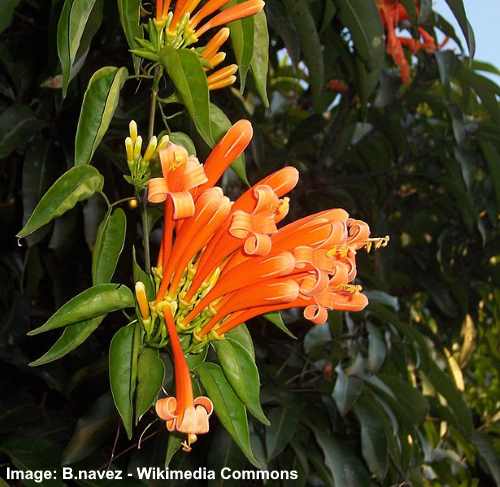
The orange flowering flame vine has fast growth rate and can quickly cover unsightly fences in Florida
Flame vine is a vigorous, sprawling vine with clusters of brightly colored orange flowers and glossy dark green foliage. The eye-catching tubular orange flowers measure 3” (7.5 cm) long and contrast nicely with the wrinkled leaves. Apart from adding color to fall gardens, the flowers on the tropical vine attract hummingbirds.
Although not native to the Sunshine State, flame vine isn’t considered invasive in the southeast. However, its fast growth means it spreads quickly, attaching itself to supports via clinging tendrils. Ideal for all regions on the Florida Peninsula, flame vine grows 6 to 12 ft. (1.8 – 3.6 m) tall and 6 ft. (1.8 m) wide.
Hardy in USDA zones 9 to 11.
Chocolate Vine (Akebia quinata)
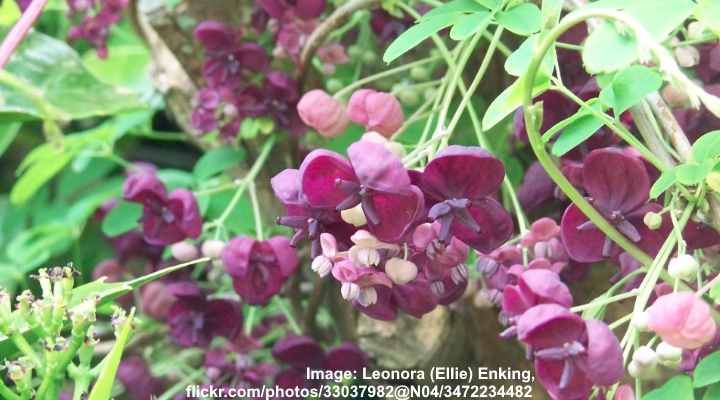
The chocolate vine has a vigorous growth and can quickly cover unattractive walls, fences or arbors
Chocolate vine is a climbing plant with fragrant, dark purple-burgundy flowers and bright green foliage. The chocolate-scented blooms appear in late spring and give way to plump sausage-like violet-colored seed pods measuring 2” (5 cm) long. Its rapid growth can make the vine uncontrollable if you don’t regularly prune it.
This semi-evergreen chocolate vine grows 20 to 40 ft. (6 – 12 m) tall and 6 to 9 ft. (1.8 – 2.7 m) wide. The fast-growing vine is perfect for quick cover for pergolas, fences, or trellises. You can also let the vine spread for ground cover in the shade to help prevent soil erosion.
Hardy in USDA zone 5 to 9.
Bougainvillea

Bougainvilleas are climbing shrubs that come in various colors and are suitable for growing in central and south Florida
Bougainvillea is a stunning woody vine with arching, climbing, and spreading stems. In Central and South Florida, the thorny shrub has evergreen foliage. However, the vining shrub’s ornamental show-stopping feature is the vibrant pink, red, white, orange or purple flower-like bracts that appear throughout the year, contrasting with dense green foliage.
Bougainvillea is the perfect addition to garden landscapes or patio gardens in the southeastern United States. The sprawling vining shrub grows 15 to 40 ft. (4.5 – 12 m) tall and wide. Due to its dense foliage and spiked woody stems, bougainvillea is an ideal security plant for Florida landscapes.
Evergreen Florida Vines (With Pictures) – Identification Guide
Evergreen vines in tropical and subtropical climates add year-long color to Florida gardens. You can plant evergreen vines as privacy screens, add height to garden beds, or cover unsightly walls and fences. Additionally, evergreen vines require minimal maintenance and are very drought tolerant, making them perfect for Florida’s hot and humid climate.
Carolina Jessamine (Gelsemium sempervirens)
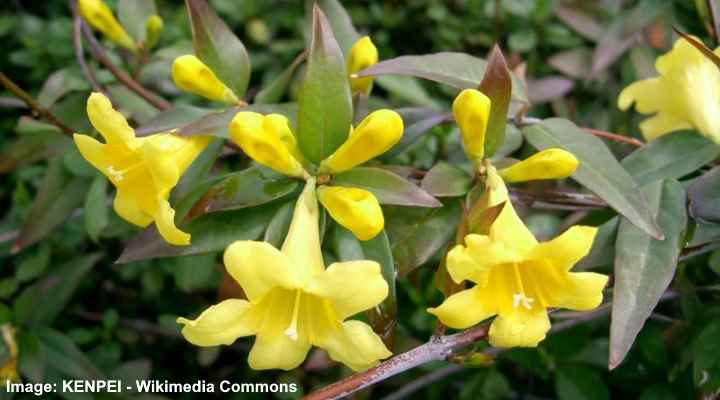
The yellow flowering Carolina jessamine is an evergreen vine that thrives in full sun but can tolerate light shade
Carolina jessamine is a fast-growing evergreen vine with beautiful yellow, trumpet-shaped flowers. The masses of bright yellow fragrant flowers cover the twining climber from late winter until spring. However, the vine also blooms sporadically throughout the year in Southern parts of the Sunshine State. The funnel-like flowers are 1.5” (3 cm) across.
This yellow-flowering vine grows 10 to 20 ft. (3 – 6 m) tall and 6 ft. (1.8 m) wide. The evergreen foliage and yellow flowers thrive in full sun throughout all regions of Florida. Suitable for USDA zones 7 to 10.
Evergreen Wisteria (Callerya reticulata)
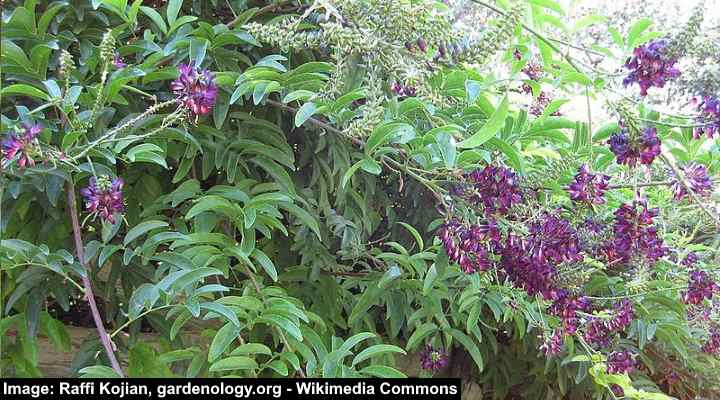
Evergreen wisteria is a purple flowering woody climber that is not related to true wisteria
Evergreen wisteria is a versatile and hardy perennial vine with fragrant purple flowers and evergreen foliage. The woody stems twist around upright supports and cover arbors, trellises, and pergolas in dense foliage and stunning blooms—ideal to provide shade in hot, humid Florida summers. Showy clusters of pea-like flowers dangle in 8” (20 cm) long racemes.
The evergreen wisteria grows 12 to 15 ft. (2.6 – 4.5 m) tall and 6 ft. (1.8 m) wide in full sun and USDA zones 8 to 11.
Blue Trumpet Vine (Thunbergia grandiflora)
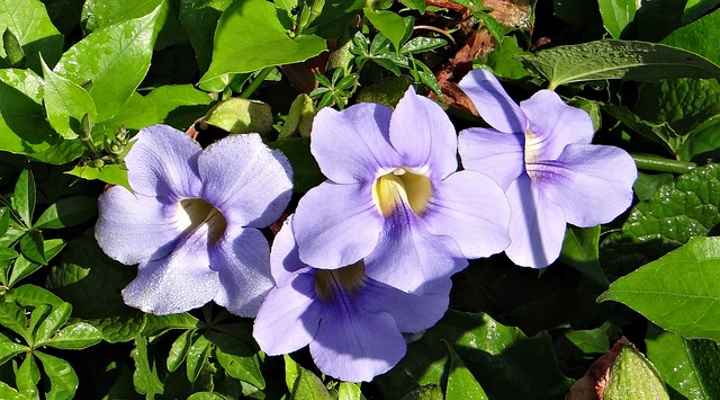
Blue sky vine has attractive pale purple flowers and grows as a perennial climber in south Florida
Blue trumpet vine is a fast-growing evergreen climber with twining stems, large, trumpet-shaped lavender-blue flowers, and heart-shaped leaves. This heat-hungry vining plant only grows outdoors throughout the year south of Lake Okeechobee. Its dense foliage of large leaves and ever-blooming pale purple flowers are perfect for hiding fences or scrambling over arbors.
Blue trumpet vine grows 6 to 8 ft. (1.8 – 2.4 m) tall and 6 ft. (1.8 m) wide. It thrives in full sun or partial shade in USDA zones 10 and 11. Apart from growing as a privacy screen, trellis plant, or over an arbor, you can grow blue trumpet vine in hanging baskets or containers.
Heart-leaf philodendron (Philodendron hederaceum var. oxycardium)
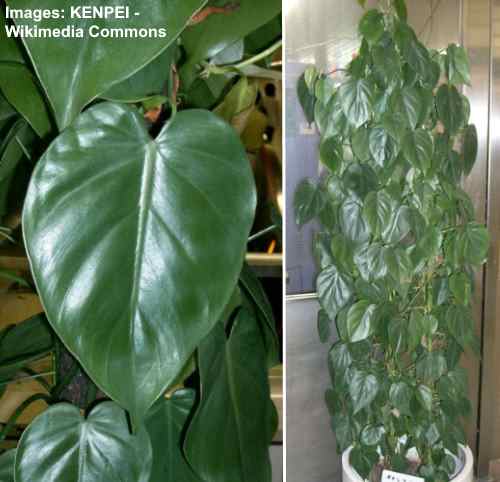
Heart-leaf philodendron is a tropical vine suitable for south Florida and the Keyes
The heart-leaf philodendron is a native evergreen vining plant native to Florida. Because the tropical vine is hardy in the warmest parts of zone 10 and 11, it is only suitable as an outdoor trailing vine or evergreen ground cover south of Miami to the Florida Keys. Growing in the ground, this vining philodendron grows up to 13 ft. (4 m) tall.
Heart-leaf philodendron can be grown as a hanging plant or climbing plant. This specific species of philodendron prefers shaded areas or medium to low light conditions.
Golden Pothos (Epipremnum aureum)
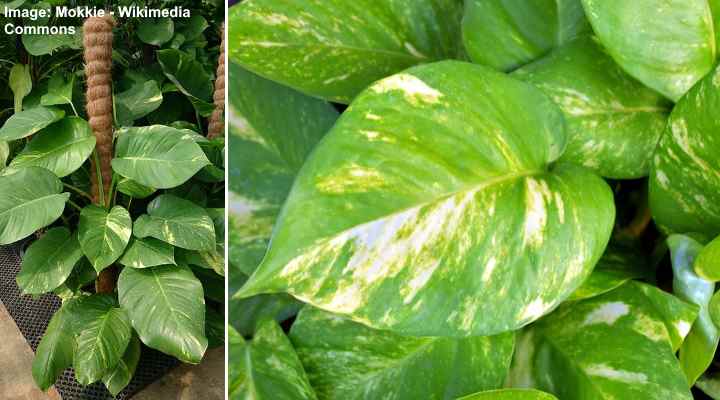
Golden pothos is a climbing plant with variegated leaves that is suitable for South Florida landscaped gardens
With its variegated yellow and green heart-shaped leaves, Golden pothos thrives in the South of Florida. The fast-growing vine is ideal for planting in the shade. The vigorous vine scrambles up tree trunks, trellises, or arbors—especially in spots where other tropical vines cannot grow in the shade.
Golden pothos is suitable for growing in USDA zones 10 and 11, and its fast-growing stems can ramble up to 40 ft. (12 m) long.
Swiss Cheese Plant (Monstera deliciosa)
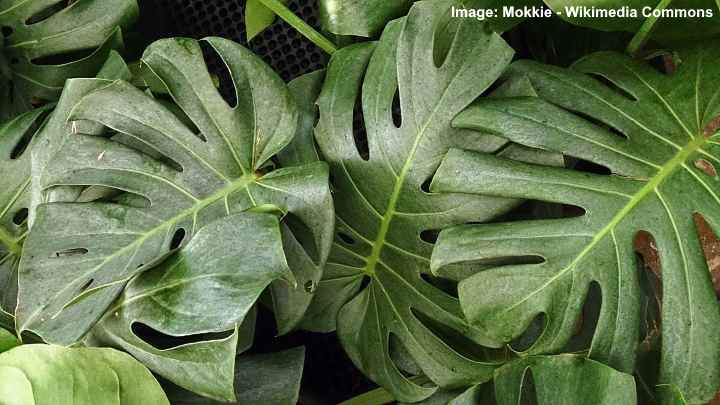
The Swiss cheese plant s a climbing, evergreen perennial vine in south Florida and the Keyes
Monstera deliciosa is an exotic broadleaf with large heart-shaped leaves with oblong splits along the margins. Also known as the split-leaf philodendron, this stunning tropical vine grows quickly. Its thick, cylindrical vines can stretch up to 70 ft. (21 m) long. It thrives in dappled sunlight in USDA zones 10 to 12.
Other Types of Florida Vines
Virginia Creeper (Parthenocissus quinquefolia)

Virginia creeper vines quickly cover unsightly Florida walls and fences with their fast growth rate and attractive autumn foliage
Virginia creeper is an excellent choice of vining plant for climbing walls or covering bare ground in Florida. The fast-growing vine has dense foliage consisting of palmate leaves containing five pointed leaflets. The stunning leaves emerge purple-bronze, mature to green in summer, and turn vibrant crimson or burgundy red in the fall. Additionally, clusters of black-blue berries appear in late fall.
Virginia creeper is native to Florida. Its ornamental landscaping features are its deep green foliage that turns stunning shades of red in autumn. The vining stems attach to structures with adhesive pads, helping the plant to cover stone walls or brick facades. Suitable for zones 3 to 11, the sprawling vine grows 30 to 50 ft. (9 – 15 m) tall and 10 ft. (3 m) wide.
Saw Greenbrier (Smilax bona-nox)
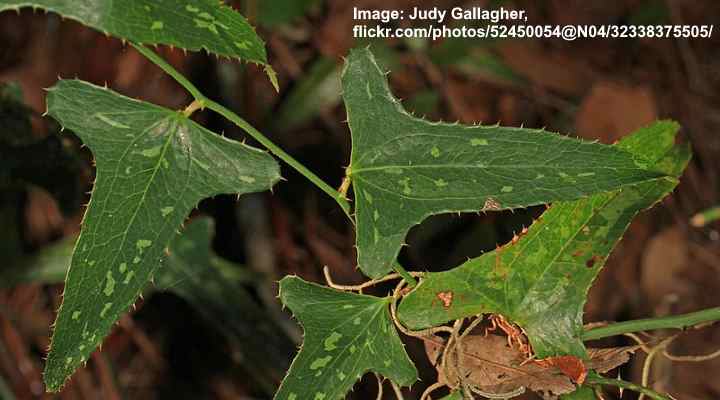
Saw greenbrier is a Florida vine that can be difficult to control due to its rapid growth rate
Saw greenbrier is a native fast-growing vining plant that thrives in shade or sun. The identifying feature of the vine is thick triangular (deltoid) leaves with deep lobes and prickly margins. Also, small greenish-whitish flowers appear in late winter and early spring. The flowering vine can grow as evergreen ground cover or privacy screening in South Florida.
Hardy in USDA zones 5 to 11, saw greenbrier stems grow around 20 ft. (6 m).
Muscadine Grape (Vitis rotundifolia)
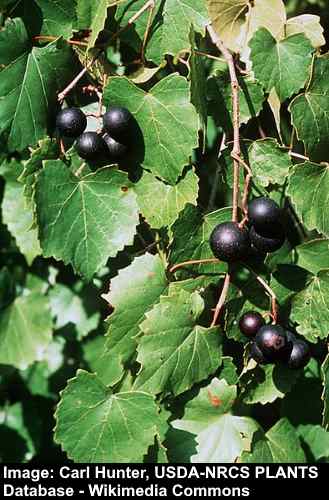
Muscadine grape is a deciduous climbing vine with edible fruit
Native to Florida, the muscadine grape variety is a high-climbing vine with dense, dark-green foliage, small flowers, and bunches of juicy fruits. Muscadine grape vines thrive in North and Central Florida, growing 60 to 80 ft. (18 – 24 m) tall. The rounded leaves with serrated margins are 4” (10 cm) wide.
After the insignificant clusters of flowers finish, bunches of dark purple rounded grapes appear. Up to 12 grapes grow on a cluster, and the edible fruits are suitable for making wine, jellies, juices, and jams. The benefit of growing native muscadine varieties in Florida is that the plants are pest free.
Related articles:
